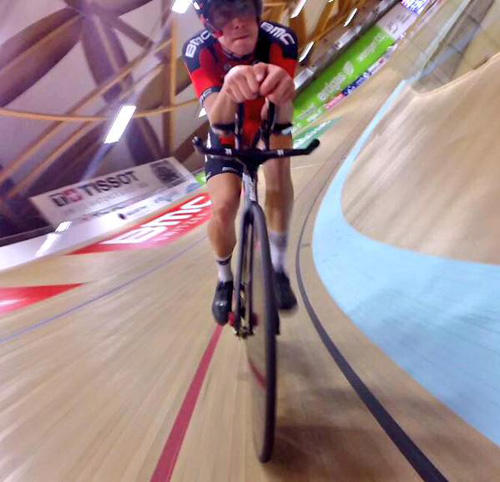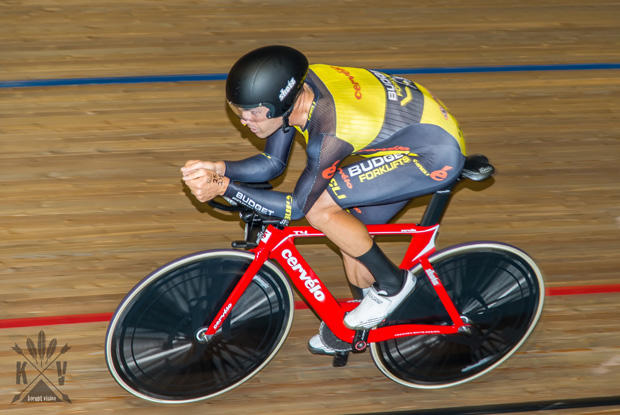Anatomy of a Record Attempt
Slowtwitcher Kevin Metcalfe (nslckevin on the reader forum) attempted to set a new world hour record last week for the 55-59 age group. He did so at a velodrome in Aquascalientes, Mexico, on July 15, 2017, with an assist from GU Energy Labs. Several riders were there with aspirations of setting records, from the 3 km distance up to the hour.
The record for Kevin’s age group stood at 47.773 km. Kevin felt as if he was capable of 49.5 km, and raced with that as a goal.
Timed records with fixed gears are not like typical races. At 35 minutes Kevin’s pace fell to 49.4 kph, which meant that he had to pedal a slightly slower cadence than he intended, because fixed gear bikes have one gear only. At the 45 minute mark he began to have trouble holding his aero position. His pace fell to 49.3 kph. More on how this ride went is below. But in the run-up to the record run here are some of the decisions and elements that led to this attempt.
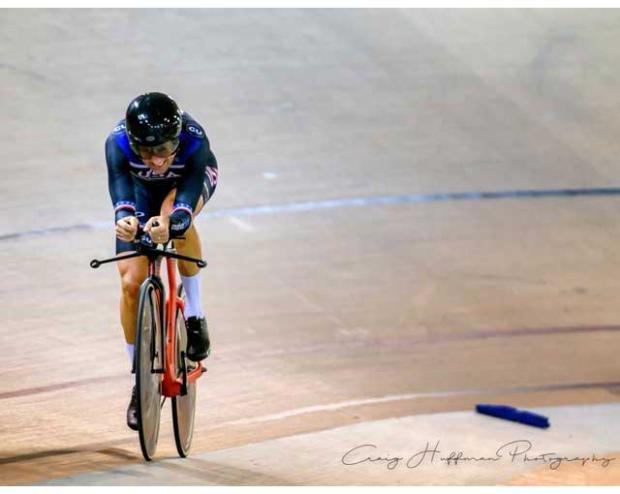
"BMC supplied us with their new Time Machine TM01 road frames,” Kevin wrote to me, and by “road frames” he means BMC’s TT frames. BMC is the bike sponsor for Peet's Coffee Racing team, the team on which Kevin rides. "The TM01 has horizontal rear dropouts,” and that made it possible to jury rig it into a fixed gear bike. He borrowed a set of FFWD disk wheels (yes, discs on the front and the rear; yes, that’s faster; yes, that’s legal).
The problem with “road” bikes is that they’re spaced 130mm between the dropouts (142mm for disc brake road), while track bikes are spaced 120mm. So, Kevin, "bought a longer axle from FFWD and added some spacers to make the axle effectively 130mm." This however, has implications on the chain line. But, he "used a road crank with the chain ring in the big ring position and actually the chain line was pretty much dead on."
(BMC does make a tool precisely for the purpose; and we've profiled it.)
The tires Kevin rode were Vittoria Pista CS with 200 PSI of air in them. Whoa! Big air! Especially against the current trend toward lower pressures. But these were narrower tires (typical of track tires, and "Pista" means track), and tire pressures trend lower as road surface trends rougher. Riding on a well-maintained wooden velodrome is like riding on a polished basketball court.
Kevin used a road power meter with 175mm cranks and road chains, chainrings and a road pitch rear cog. He used his Specialized Shiv as a fit model, and built the BMC TM01 to be the Shiv’s fit duplicate.
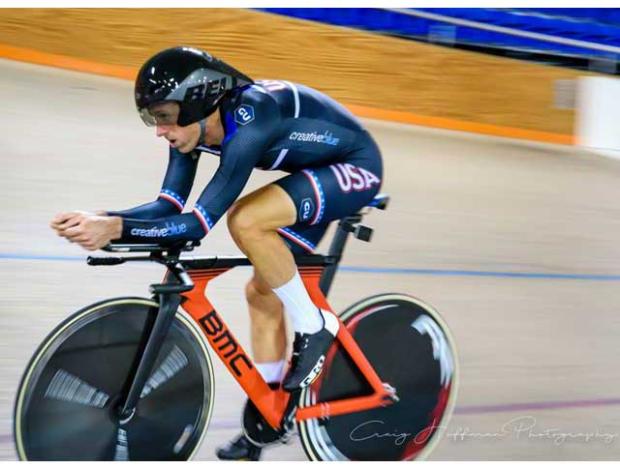
He tested his new BMC “track” bike at his hometown Hellyer Park Velodrome (San Jose, CA) and it was fine.
Kevin felt he could ride 50 km at high altitude Aguascalientes (6,200 feet above sea level). "This was based on what I had done at Hellyer, my power output for my national 40km TT record in Loyalton (a 5000 foot flat TT course just north of Lake Tahoe) in June; and what I like to call “Rob’s Magic Spreadsheet”. This is a set of calculations conceived of by Rob Van Houweling; I’ve seen the spreadsheet but I can’t publish it. Inputs include air density, temperature, and other factors that generate a CdA; then apparent wind, power, power to wheel, elevation change and so forth. The output is the predicted finish time. All this was based on an assumption that Kevin could hold 305 watts for his hour.
"Once in Aguascalientes though, testing in a 53×14 felt 'too heavy'. I didn’t feel like I could stay on top of that gear coming out of the corners into the straightaways,” Kevin wrote me. "Further testing in the 52×14 felt much better and pointed towards being able to comfortably ride laps in 18-18.1 seconds. From there I decided to shoot for a schedule of 49.5 kph (18.1 second laps). If I felt good with 20 minutes to go I could always step on the gas and shoot for 50. That turned out to not be the case though. Based on my schedule I was shooting for an average cadence of maybe 108. I find that to be a very comfortable cadence on the track.”
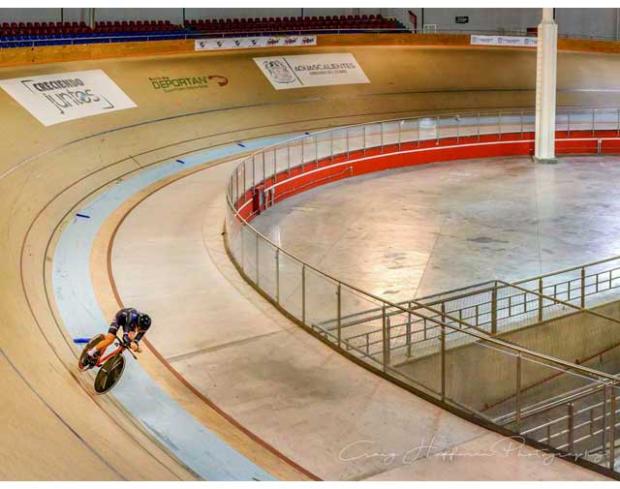
A cadence of 108 is somewhat high for the top hour riders, but not overly so, hour records have been set with cadences in the mid-90s, but high-90s to low-100s is more typical.
"The first half went well. Using Rob’s automated timing system and an iPad display I could see my splits every lap. Much (!) better than trying to shout – and hear – lap splits with an aero helmet on for an hour! Every 5 minutes a white board was shown to me, with minutes done and my average speed up to then.
"For the first 35 minutes I was right on at 49.5 kph. But then the 18.1’s and 2’s started turning into 18.3, 4, 5. I also started having more lapses where I went wide coming out of a corner and hit some sponges. I think that it was partly physical fatigue, but also lapses of concentration. With 20 minutes to go I started counting laps. I figured that by the time I saw the board I was already 1 lap into that 5-minute stretch and figured I was probably averaging around 17 laps per 5 minutes. Doing that gave me a sense of progress.
"Doing my 2×20 minute trainer workouts in the winter I break it down into 5-minute blocks. Same thing here. I broke the hour into 5-minute blocks and then toward the end I broke those 5 minute blocks into 17-lap groups.
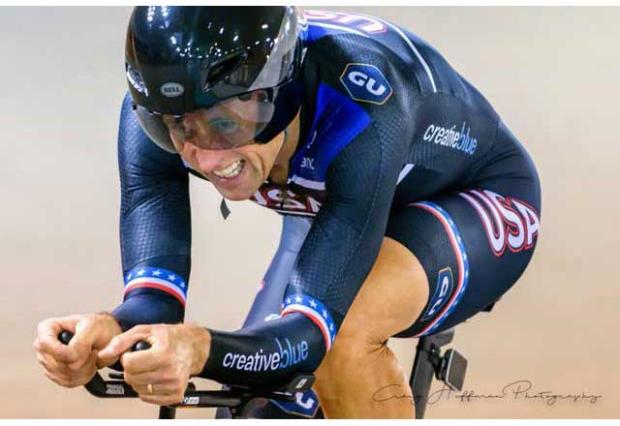
"Each lap felt like I was making tangible progress towards the next 5-minute marker. Much better mentally than each lap going around and asking myself, ‘Isn’t the 5 minutes up yet?’"
For those considering what seems to be an annual Aguascaliente pilgrimage to try to break records from 3 km up to the hour, it’s a 250 meter track, which is shorter than the 335 meter track in Kevin's hometown. “Riding the black line” takes a lot of skill, if you want to ride the shortest distance, and there is a technique that Kevin and others used, where they rode the (very steep) turns hard and more or less coasted the straightaways.
"The last five minutes was just all I had left,” he said. "Toward the end I couldn’t really even pay too much attention to the lap splits.” He said it got close to horrible at the end – pretty close to the hardest thing he’s ever done.
For those interested in a rider's eye view of this effort, here you go:
Kevin Metcalfe's official distance at the end was 49.121 km, breaking the old age-group world record by 1.348 kilometers.
[All photos courtesy of Craig Huffman Photography]


